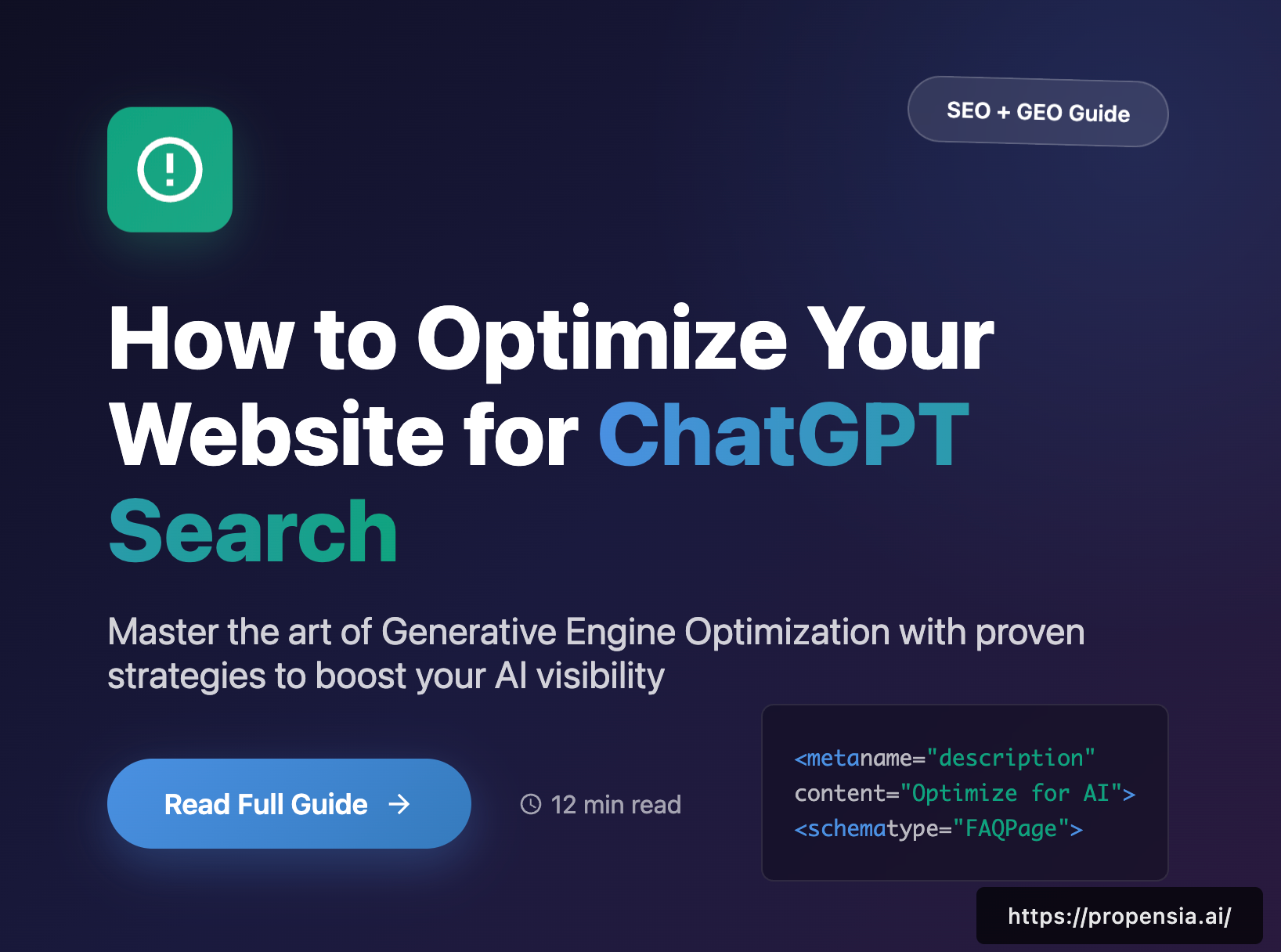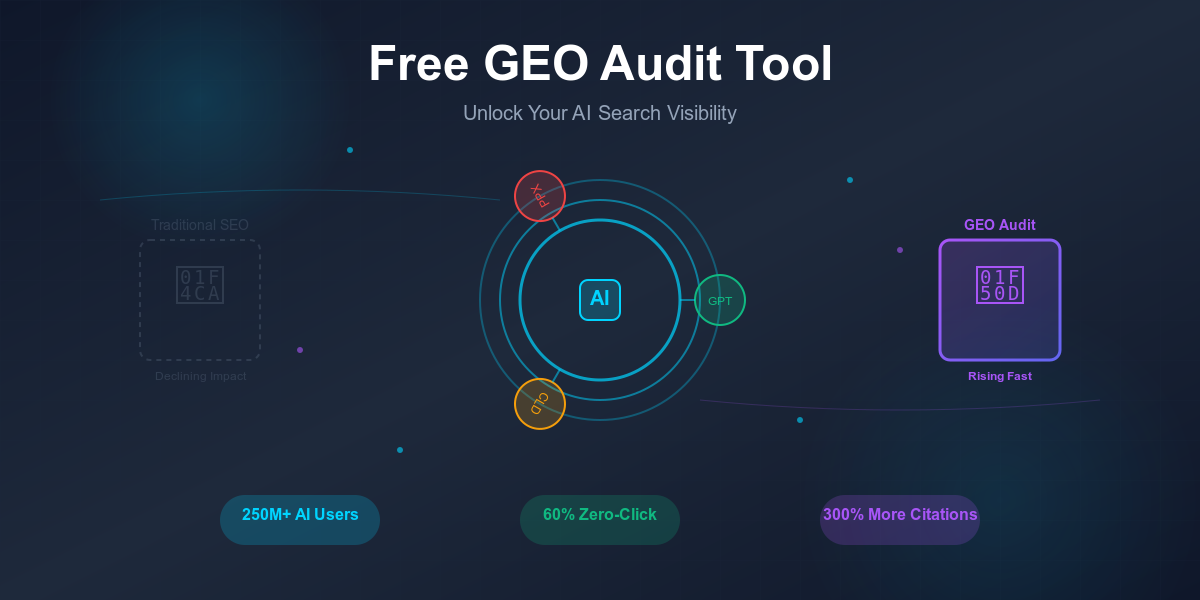ChatGPT has fundamentally changed how people search for information online. With millions of users asking ChatGPT questions daily, ensuring your website appears in its responses has become crucial for digital visibility. This comprehensive guide reveals exactly how to optimize your website for ChatGPT search through proven Generative Engine Optimization (GEO) strategies.
What is ChatGPT Search and Why Does It Matter?
ChatGPT search represents a paradigm shift from traditional keyword-based queries to conversational information discovery. Unlike Google, where users type keywords, ChatGPT users ask complete questions and expect comprehensive, contextual answers. When ChatGPT references your content in its responses, it establishes your brand as an authoritative source, driving both direct traffic and building long-term credibility.
The impact is significant: businesses properly optimized for ChatGPT search report up to 300% increases in brand mentions and substantial growth in referral traffic. As AI-powered search continues growing, early optimization efforts compound into lasting competitive advantages.
Understanding How ChatGPT Processes and Ranks Content
ChatGPT's content evaluation differs fundamentally from traditional search engines. While Google primarily considers keywords, backlinks, and user signals, ChatGPT focuses on content clarity, factual accuracy, and structural organization. The AI model prioritizes sources that present information in easily digestible formats with clear hierarchies and logical flow.
ChatGPT particularly values content that directly answers common questions, provides comprehensive coverage of topics, and maintains consistent factual accuracy. Understanding these preferences allows you to structure content that ChatGPT naturally gravitates toward when formulating responses.
Essential GEO Strategies for ChatGPT Optimization
Content Structure and Formatting
Proper content structure forms the foundation of ChatGPT optimization. Use clear heading hierarchies with descriptive H1, H2, and H3 tags that outline your content's organization. Each section should address a specific subtopic or question, making it easy for ChatGPT to extract relevant information.
Format your content with short paragraphs, bullet points for lists, and numbered steps for processes. This structured approach helps ChatGPT understand and reference your content accurately. Include summary sections at the beginning of long articles, as ChatGPT often pulls from these overviews when crafting responses.
Question-Based Content Creation
Since ChatGPT users ask questions, structure your content to directly answer common queries in your industry. Start sections with the question as a heading, then provide comprehensive answers immediately below. This Q&A format aligns perfectly with how ChatGPT processes and delivers information.
Research common questions in your field using tools like Answer The Public, Google's People Also Ask, and industry forums. Create dedicated pages or sections addressing each major question cluster, ensuring thorough coverage that ChatGPT can reference.
Schema Markup Implementation
Structured data helps ChatGPT understand your content's context and relationships. Implement comprehensive schema markup including:
Article schema for blog posts with author, date, and topic information
FAQ schema for question-and-answer content
HowTo schema for instructional content
Organization schema for business information
Product schema for e-commerce content
Rich schema markup increases the likelihood of ChatGPT accurately interpreting and citing your content, as it provides explicit context about your information's purpose and structure.
Technical SEO Factors That Influence ChatGPT
Page Load Speed and Performance
While ChatGPT doesn't directly measure page speed, faster-loading pages get crawled more frequently and completely. Optimize your site's performance by:
Compressing images and using modern formats like WebP
Minimizing CSS and JavaScript files
Implementing lazy loading for below-fold content
Using content delivery networks (CDNs) for global accessibility
Enabling browser caching for repeat visitors
Better technical performance ensures ChatGPT's training data includes your most current content, improving citation accuracy and frequency.
Mobile Optimization and Accessibility
ChatGPT's training data includes mobile-indexed content, making responsive design crucial. Ensure your content displays properly across all devices with:
Responsive layouts that adapt to screen sizes
Touch-friendly navigation elements
Readable font sizes without zooming
Accessible color contrasts and alt text for images
Proper heading structures for screen readers
Accessible content benefits both human users and AI systems attempting to understand your information.
URL Structure and Site Architecture
Create clear, descriptive URLs that indicate content topics. Use hyphens between words, keep URLs concise, and maintain logical site hierarchies. Implement proper internal linking to help ChatGPT understand relationships between your content pieces.
Organize content into clear categories and use breadcrumb navigation. This structural clarity helps ChatGPT contextualize individual pages within your broader content ecosystem.
Creating ChatGPT-Friendly Content
Writing Style and Clarity
Write in clear, concise language that prioritizes factual accuracy over marketing rhetoric. ChatGPT favors content that:
Uses simple, direct sentences
Defines technical terms clearly
Provides specific examples and data
Avoids excessive jargon or buzzwords
Maintains consistent terminology throughout
Focus on educational value rather than promotional messaging. ChatGPT typically references content that genuinely helps users understand topics rather than content that primarily sells products or services.
Comprehensive Topic Coverage
Create thorough content that addresses topics from multiple angles. ChatGPT often synthesizes information from comprehensive sources rather than pulling from multiple shallow articles. Develop pillar content that covers:
Basic definitions and concepts
Advanced applications and variations
Common misconceptions and clarifications
Real-world examples and case studies
Related topics and connections
This depth establishes your content as an authoritative source ChatGPT can confidently reference.
Regular Content Updates
Keep content current with regular updates, as ChatGPT's training includes temporal awareness. Add update timestamps to show content freshness, revise statistics and data points quarterly, and expand sections based on new developments.
Create a content maintenance schedule that ensures your most important pages remain accurate and comprehensive. This ongoing optimization maintains your relevance in ChatGPT's responses over time.
Building Authority for ChatGPT Recognition
E-E-A-T Signals
Demonstrate Experience, Expertise, Authoritativeness, and Trustworthiness through:
Detailed author bios with credentials and expertise
Citations to reputable sources and research
Case studies showing real-world application
Testimonials and social proof elements
Industry certifications and affiliations
ChatGPT's training recognizes these authority signals, making it more likely to reference content from established experts and trusted sources.
Brand Consistency and Recognition
Maintain consistent branding and messaging across your content. Use your brand name naturally within content, create a distinctive voice and perspective, and develop signature frameworks or methodologies. This consistency helps ChatGPT associate your brand with specific topics and expertise areas.
Strategic Internal and External Linking
Build strong internal linking structures that connect related content and establish topical authority. Link to authoritative external sources to support your claims and demonstrate research depth. This linking strategy helps ChatGPT understand your content's credibility and context.
Measuring ChatGPT Optimization Success
Key Performance Indicators
Track your ChatGPT optimization progress through:
Brand mention frequency in ChatGPT responses
Referral traffic from AI-generated content
Keyword rankings for question-based queries
Content engagement metrics and time on page
Conversion rates from AI-driven traffic
Use tools specifically designed for GEO monitoring, as traditional SEO metrics don't fully capture AI search performance.
Testing and Iteration
Regularly test how ChatGPT responds to queries in your industry. Document which content gets referenced most frequently and analyze patterns in successful content. Use these insights to refine your optimization strategy continuously.
Create test queries that potential customers might ask and evaluate whether your content appears in responses. This hands-on approach reveals optimization opportunities and content gaps.
Advanced ChatGPT Optimization Techniques
Semantic Content Optimization
Develop content that covers semantic variations and related concepts. ChatGPT understands context and relationships, so comprehensive semantic coverage improves citation likelihood. Include:
Synonyms and alternative terminology
Related concepts and connections
Industry-specific variations
Regional terminology differences
Historical context and evolution
This semantic richness helps ChatGPT reference your content for a broader range of queries.
Multi-Format Content Strategy
Diversify content formats to maximize ChatGPT accessibility:
Written articles with clear structure
Infographics with descriptive alt text
Video content with detailed transcripts
Podcasts with comprehensive show notes
Interactive tools with explanatory content
Different formats provide multiple entry points for ChatGPT to discover and reference your information.
Competitive Analysis and Positioning
Study which competitors ChatGPT currently references and analyze their content strategies. Identify gaps in their coverage and create superior content that addresses these opportunities. Position your content as the more comprehensive, accurate, or recent alternative.
Common ChatGPT Optimization Mistakes to Avoid
Over-Optimization Pitfalls
Avoid keyword stuffing or unnatural repetition, as ChatGPT recognizes and may penalize manipulative tactics. Don't create thin content targeting every possible query variation. Focus on quality over quantity, developing fewer but more comprehensive pieces.
Technical Errors
Ensure proper indexing and crawlability. Avoid blocking important content with robots.txt or noindex tags. Fix broken links and redirect chains that could prevent ChatGPT from accessing your content. Maintain consistent URL structures without frequent changes.
Content Quality Issues
Don't publish inaccurate or outdated information, as ChatGPT's training emphasizes factual correctness. Avoid duplicate content across pages, which can confuse AI systems about the authoritative source. Ensure all claims are properly supported with evidence or citations.
Future-Proofing Your ChatGPT Optimization Strategy
As AI search technology evolves, maintain flexibility in your optimization approach. Stay informed about ChatGPT updates and changes in AI search behavior. Experiment with new content formats and optimization techniques as they emerge.
Build a sustainable content creation process that prioritizes user value over algorithmic manipulation. This user-first approach ensures your content remains valuable regardless of how AI search technology develops.
Conclusion: Taking Action on ChatGPT Optimization
ChatGPT search optimization represents a critical evolution in digital marketing strategy. By implementing these GEO best practices—from structured content creation to technical optimization and authority building—you position your website for success in the AI-powered search landscape.
Start with fundamental improvements like proper heading structure and question-based content. Gradually implement advanced techniques as you build expertise. Remember that ChatGPT optimization is an ongoing process requiring consistent effort and adaptation.
The businesses investing in ChatGPT optimization today will dominate AI search results tomorrow. Begin your optimization journey now to secure your position in this rapidly evolving digital landscape. Every piece of content optimized for ChatGPT builds cumulative advantage, establishing your brand as the authoritative source AI systems trust and reference.
Take the first step today: audit your existing content for ChatGPT optimization opportunities, implement proper structure and schema markup, and start creating question-focused content that directly serves your audience's needs. The future of search is conversational, and your content needs to join the conversation.

